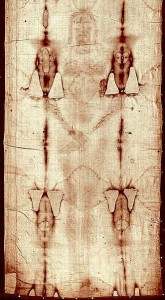 Yes, in our opinion, the Shroud of Turin is a hoax.
Yes, in our opinion, the Shroud of Turin is a hoax.The Times now reports on the display of the Shroud of Turin, "Shroud skeptics call on a shopping list of evidence, including traces of paint pigments and carbon-14 dating tests carried out in 1988 that led three independent laboratories to date the cloth between 1260 and 1390, to cast doubt on its sacred origins."
We addressed this issue on 1/31/10, reposted here...
New evidence from Israel leads us to ask if the famous Shroud of Turin, alleged to be from the time of Jesus, is a hoax?
The report in the Archaeology Magazine blog concludes, "No one will be able to draw any definitive conclusions about the authenticity of the Shroud of Turin based on this new study, "Molecular Exploration of the First-Century Tomb of the Shroud in Akeldama, Jerusalem".
The comparative sample size is miniscule, and archaeologists need to see much more in the way of Jewish burial shrouds from the period in order to establish what the customs really were. However, this evidence is the best we have at the moment, and it certainly casts a lot of new doubt on the Shroud of Turin."
What is the new evidence?
In December, Shimon Gibson, an archaeologist and senior research fellow at the W.F. Albright Institute of Archaeological Research in Jersualem, announced tantalizing results from a new study that he and Boaz Zissu, an archaeologist at Bar Ilan University, just completed on a 1st century B.C. shrouded burial they excavated in a tomb in Jerusalem. Gibson and several colleagues published the first part of the study in a paper in PLoS One on December 16th.... more...
The entire study will clearly shed much new light on the authenticity of the more famous Shroud of Turin. As the team points out in the PLoS One paper, archaeologists rarely find ancient shrouded burials in the Jerusalem region: the city’s high levels of humidity quickly destroy organic materials. So, as Gibson recently explained to a reporter at The Catholic Review, ”this is the first shroud from Jesus’ time found in Jerusalem and the first shroud found in a type of burial cave similar to that which Jesus would have been buried in, and (because of this) it is the first shroud which can be compared to the Turin shroud.”
Gibson and his colleagues radiocarbon-dated the tattered vestiges of the excavated shroud to 95 B.C.E . And their careful examination revealed that the mourners in question employed two very different pieces of cloth to wrap the unknown dead male. They wrapped the individual’s head in linen cloth, and his body in wool cloth–a practice that Gibson says was part of traditional Jewish burial practices at the time. Moreover, this practice fits with the biblical description of the two pieces of cloth that Jesus cast off after he rose from the dead. The Shroud of Turin, by comparison, consists of just one large piece of cloth said to have covered both the head and body of Jesus.
And Gibson and his team found another critical difference. The tattered cloths they excavated were woven very simply, with a two-way weave. The Shroud of Turin, however, exhibits a more sophisticated weaving pattern, known as a twill weave.
No comments:
Post a Comment